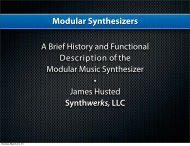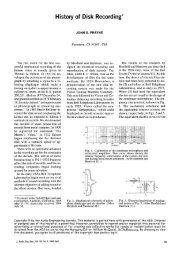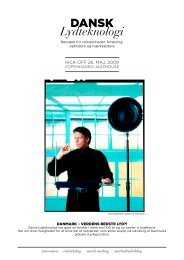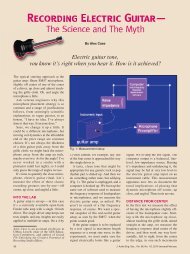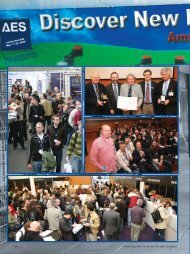Effect of Sound Intensity Level on Judgement of - Audio Engineering ...
Effect of Sound Intensity Level on Judgement of - Audio Engineering ...
Effect of Sound Intensity Level on Judgement of - Audio Engineering ...
Create successful ePaper yourself
Turn your PDF publications into a flip-book with our unique Google optimized e-Paper software.
ture <str<strong>on</strong>g>of</str<strong>on</strong>g> potential c<strong>on</strong>fusi<strong>on</strong> bordering <strong>on</strong><br />
chaos. Here, at 50 db intensity-level, dif-'<br />
ferential effects <str<strong>on</strong>g>of</str<strong>on</strong>g> high-pass filtering<br />
have almost disappeared. Any discrim- - $<br />
inati<strong>on</strong> am<strong>on</strong>g the three bands must be A<br />
made <strong>on</strong> the basis <str<strong>on</strong>g>of</str<strong>on</strong>g> changes at the high<br />
end al<strong>on</strong>e. Since there is relatively little g<br />
difference between "narrow" (C) and S<br />
"medium" (B) for the listener (perhaps<br />
<strong>on</strong>e-third <str<strong>on</strong>g>of</str<strong>on</strong>g> an octave above 5,000 cps<br />
too 1000<br />
at 1 s<strong>on</strong>e loudness), we would anticipate<br />
FREQUENCY -CYCLES PER SECOND<br />
4<br />
largely unreliable judgments <str<strong>on</strong>g>of</str<strong>on</strong>g> preference<br />
for <strong>on</strong>e or the other. However, the Fig. 7. Subjective effect <str<strong>on</strong>g>of</str<strong>on</strong>g> Eisenberg and<br />
Chinn's "wide," "mediun" and "narrow t<strong>on</strong>al<br />
subjective difference between '%ide,, range" filters at 60-db intensity-level ("mod-<br />
(A) and "narr~~" (C) is more evident, erate volume level"). Broken lines indicate<br />
and likely would prodbce more satisfac-<br />
cut<str<strong>on</strong>g>of</str<strong>on</strong>g>f effect <str<strong>on</strong>g>of</str<strong>on</strong>g> filters.<br />
tory indicati<strong>on</strong>s <str<strong>on</strong>g>of</str<strong>on</strong>g> preference.<br />
Eisenberg and Chinn's preferred combiq$ti<strong>on</strong>s<br />
<str<strong>on</strong>g>of</str<strong>on</strong>g> "t<strong>on</strong>al range" and "volume<br />
level" appear in the left-hand columns.<br />
From their results as here interpreted, .<br />
there emerge two facts <str<strong>on</strong>g>of</str<strong>on</strong>g> c<strong>on</strong>siderable<br />
importance. First, out <str<strong>on</strong>g>of</str<strong>on</strong>g> the twenty<br />
combinati<strong>on</strong>s <str<strong>on</strong>g>of</str<strong>on</strong>g> band-pass filtering, intensity-level,<br />
and musical c<strong>on</strong>tent which<br />
their listenefs were yked to evaluate,<br />
<strong>on</strong>ly the nine shown here appear to have<br />
produced adequately reliable statements<br />
<str<strong>on</strong>g>of</str<strong>on</strong>g> preference. This suggests that in the<br />
remaining eleven, judgment was complicated<br />
by inadequate discriminability<br />
<str<strong>on</strong>g>of</str<strong>on</strong>g> the c<strong>on</strong>diti<strong>on</strong>s <str<strong>on</strong>g>of</str<strong>on</strong>g>fered for comparis<strong>on</strong>,<br />
due either to the -effects <str<strong>on</strong>g>of</str<strong>on</strong>g> combining<br />
frequency-range and intensity-level, or<br />
In the experiments c<strong>on</strong>ducted by 01-<br />
to failure <str<strong>on</strong>g>of</str<strong>on</strong>g> the musical samples to sufs<strong>on</strong>,<br />
intensity-level was maintained at 75<br />
ficiently occupy the porti<strong>on</strong>s <str<strong>on</strong>g>of</str<strong>on</strong>g> sppctrum<br />
db throughout, and but two frequency-<br />
st~died.~ The sec<strong>on</strong>d important point is<br />
range c<strong>on</strong>diti<strong>on</strong>s were compared-unrestricted<br />
bandwidth, and a nominal 5,000<br />
cps low-pass. Figu~e 9 shows the physical<br />
effect <str<strong>on</strong>g>of</str<strong>on</strong>g> the frequency-range c<strong>on</strong>trols<br />
imposed in this experiment, while<br />
Fig. 10 represents the subjective effect<br />
<str<strong>on</strong>g>of</str<strong>on</strong>g> these c<strong>on</strong>trols. Observe that at the<br />
high frequency end this curve compares<br />
favorably with that for Eisenberg and<br />
Chinn's "narrow range" at 70 db (Fig.<br />
6, curve C), while the curve representing<br />
the effect <str<strong>on</strong>g>of</str<strong>on</strong>g> Ols<strong>on</strong>'s unrestricted<br />
c<strong>on</strong>diti<strong>on</strong> closely .resembles Eisenberg<br />
and Chinn's "wide-range" curve at<br />
"high volume level" (Fig. 2, 70 db).<br />
From these observati<strong>on</strong>s we might infer<br />
that as far as the high-frequency end <str<strong>on</strong>g>of</str<strong>on</strong>g><br />
the range is c<strong>on</strong>cerned, there was little<br />
difference between the discriminati<strong>on</strong><br />
task presented Ols<strong>on</strong>'s listeners and that<br />
c<strong>on</strong>fr<strong>on</strong>ting Eisenberg and Chinn's.<br />
Also, we may predict that Ols<strong>on</strong>'s two<br />
passbands should be easily discriminable<br />
<strong>on</strong> the. basis <str<strong>on</strong>g>of</str<strong>on</strong>g> their subjective differences,<br />
and therefore give rise to highly<br />
reliable estimates <str<strong>on</strong>g>of</str<strong>on</strong>g> preference for <strong>on</strong>e<br />
or the other.<br />
Analysis <str<strong>on</strong>g>of</str<strong>on</strong>g> Tests<br />
11 FREQUENCY - CYCLES PER SECOND I<br />
Fig. 8. Subjective effect <str<strong>on</strong>g>of</str<strong>on</strong>g> Eisenberg and<br />
Chinn's "wide," "medium" and "narrow t<strong>on</strong>al<br />
range" filters at 50-db intensity-level ("low<br />
volume l'evel"). Broken lines indicate cut<str<strong>on</strong>g>of</str<strong>on</strong>g>f<br />
effect <str<strong>on</strong>g>of</str<strong>on</strong>g> filters.<br />
FILTER<br />
OUT<br />
0<br />
-10 -<br />
-20 -<br />
-30 -<br />
-40 -<br />
5 4 i 6 i<br />
100 1000 1OOOO<br />
FREQUENCY -CYCLES PER SECOND I Fig. 9. Approximate resp<strong>on</strong>se characteristic <str<strong>on</strong>g>of</str<strong>on</strong>g><br />
acoustical filter system used in Ols<strong>on</strong>'s study<br />
<str<strong>on</strong>g>of</str<strong>on</strong>g> preference for frequelrcy range, showing<br />
acoustical cut<str<strong>on</strong>g>of</str<strong>on</strong>g>f <str<strong>on</strong>g>of</str<strong>on</strong>g> "5000-cps" low-pass<br />
filter.<br />
indicated by the asterisks appearing in<br />
the left-hand column <str<strong>on</strong>g>of</str<strong>on</strong>g> the upper table.<br />
Five out <str<strong>on</strong>g>of</str<strong>on</strong>g> nine <str<strong>on</strong>g>of</str<strong>on</strong>g> the reliably preferred<br />
combinati<strong>on</strong>s yield passbands which are<br />
subjectively broader than their n<strong>on</strong>-preferred<br />
counterparts, although by plzysical<br />
definiti<strong>on</strong> they are narrower. To<br />
some extent, the authors may have bekn<br />
aware <str<strong>on</strong>g>of</str<strong>on</strong>g> this apparent anomaly, for<br />
they c<strong>on</strong>clude that "the most reliable<br />
judgments were made when both toqal<br />
range and volume level were varied."T<br />
.However, the findings reported here<br />
str<strong>on</strong>gly suggest that their prime c<strong>on</strong>clusi<strong>on</strong>,<br />
"listeners prefer either a narrow<br />
or medium t<strong>on</strong>al range to a wide <strong>on</strong>e,"s<br />
may deserve careful reviewing. Submitting<br />
the results <str<strong>on</strong>g>of</str<strong>on</strong>g> Ols<strong>on</strong> to similar<br />
analysis, we do not find evidence <str<strong>on</strong>g>of</str<strong>on</strong>g> such<br />
c<strong>on</strong>taminating factors. (Table I) Evidently<br />
the passbands and intensity-level<br />
used so unequivocally structured the<br />
judgmental situati<strong>on</strong>, and were so occupied<br />
by the spectra <str<strong>on</strong>g>of</str<strong>on</strong>g> the musical<br />
samples chosen, that his listeners could<br />
make their choices relatively unhampered<br />
by doubt. All <str<strong>on</strong>g>of</str<strong>on</strong>g> the judgments<br />
rendered by his unselected listeners meet<br />
the criteri<strong>on</strong> for reliability, and definitely<br />
favor wide-passband transmissi<strong>on</strong><br />
over narrow.<br />
If the preceding arguments be ac-<br />
[C<strong>on</strong>tinued <strong>on</strong> page 26 1<br />
The published results <str<strong>on</strong>g>of</str<strong>on</strong>g> the two<br />
studies cited here have been analyzed<br />
for the purpose <str<strong>on</strong>g>of</str<strong>on</strong>g> estimating the relia-<br />
bility <str<strong>on</strong>g>of</str<strong>on</strong>g> preferences indicated by the.lis-<br />
teners. The results <str<strong>on</strong>g>of</str<strong>on</strong>g> this analysis are<br />
shown in Table I. Only the preferences<br />
<str<strong>on</strong>g>of</str<strong>on</strong>g> the "cross-secti<strong>on</strong>", or unspecialized,<br />
listeners are Geated, <strong>on</strong> the grounds that<br />
they are more representative <str<strong>on</strong>g>of</str<strong>on</strong>g> the gen-<br />
eral populati<strong>on</strong> than would be the judg-<br />
ments <str<strong>on</strong>g>of</str<strong>on</strong>g>, say, pr<str<strong>on</strong>g>of</str<strong>on</strong>g>essi<strong>on</strong>al musicians,<br />
high-fidelity enthusiasts, audio engi-<br />
neers, or other specialists. This * table<br />
summarizes <strong>on</strong>ly the testing in which<br />
music was used. It lists the preference-<br />
statements <str<strong>on</strong>g>of</str<strong>on</strong>g> whose occurrence we can<br />
be reas<strong>on</strong>ably sure 99 or more times out<br />
<str<strong>on</strong>g>of</str<strong>on</strong>g> 100 ('f.01 level <str<strong>on</strong>g>of</str<strong>on</strong>g> c<strong>on</strong>fidence").<br />
AUDIO ENGINEERING JUNE, 1951<br />
\<br />
\<br />
FILTER lN\<br />
1<br />
\ t<br />
\<br />
4 1 t<br />
too0 iwGQ<br />
I FREOUENCY -CYCLES PER SECOND 1<br />
Fig. 10. Subjective effect <str<strong>on</strong>g>of</str<strong>on</strong>g> Ols<strong>on</strong>'s "wide"<br />
and "narrow frequency range" filters at 75-db<br />
intensity-level. Broken line shows cut<str<strong>on</strong>g>of</str<strong>on</strong>g>f effect<br />
due to filter. Note similarity between this low-<br />
pass cut<str<strong>on</strong>g>of</str<strong>on</strong>g>f effect and that <str<strong>on</strong>g>of</str<strong>on</strong>g> Eisenberg and<br />
Chinn's "narrow t<strong>on</strong>al range" at "high volume<br />
level" (70-db curve, Fig. 5).<br />
In designing tests <str<strong>on</strong>g>of</str<strong>on</strong>g> this sort, <strong>on</strong>e must<br />
be aware that a mere statement <str<strong>on</strong>g>of</str<strong>on</strong>g> the range<br />
<str<strong>on</strong>g>of</str<strong>on</strong>g> frequencies which his apparatus will<br />
, transmit is insufficient evidence that this<br />
range was actually occupied by the sound<br />
<strong>on</strong> which the listeners had to base their<br />
preferences. Neither <str<strong>on</strong>g>of</str<strong>on</strong>g> the studies reviewed<br />
in this paper makes any direct menti<strong>on</strong> <str<strong>on</strong>g>of</str<strong>on</strong>g><br />
the frequency c<strong>on</strong>tent <str<strong>on</strong>g>of</str<strong>on</strong>g> the program material<br />
used. Some sort <str<strong>on</strong>g>of</str<strong>on</strong>g> sp,ectral analysis is<br />
plainly required in order to dem<strong>on</strong>strate<br />
the physical effect <str<strong>on</strong>g>of</str<strong>on</strong>g> the frequency-restricting<br />
c<strong>on</strong>trols imposed..<br />
' Zbid., p. 390.<br />
LOC. cit.<br />
19



